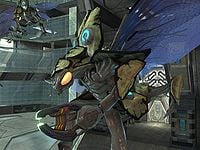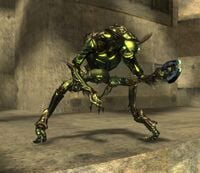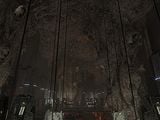Yanme'e: Difference between revisions
From Halopedia, the Halo wiki
(→Trivia) |
|||
| Line 126: | Line 126: | ||
*Although the Yanme'e have been a part of the Covenant since at least before 2525, they were, along with the [[Huragok]], predominantly used as technicians on board vessels until their effectiveness in combat was discovered during the attacks on New Mombasa. Also, despite their primitive appearance and mentality, Drones are actually an advanced race, and had attained "Tier 4" on the Forerunner Technological Advancement Scale, prior to their joining the Covenant. | *Although the Yanme'e have been a part of the Covenant since at least before 2525, they were, along with the [[Huragok]], predominantly used as technicians on board vessels until their effectiveness in combat was discovered during the attacks on New Mombasa. Also, despite their primitive appearance and mentality, Drones are actually an advanced race, and had attained "Tier 4" on the Forerunner Technological Advancement Scale, prior to their joining the Covenant. | ||
*[[Flood]] infected Drones have not been seen, likely because a Drone has no basic skeleton upon which the Flood organism grafts its biomass into. However, the chitinous shells and liquid innards may be used as a source of biomass. | *[[Flood]] infected Drones have not been seen, likely because a Drone has no basic skeleton upon which the Flood organism grafts its biomass into. However, the chitinous shells and liquid innards may be used as a source of biomass. | ||
*In ''[[Halo 2]]'', if a Drone is shot and killed in a certain way, their wings will jut out from their coverings like they were about to take off similar to that of a swatted fly or mosquito. | *In ''[[Halo 2]]'', if a Drone is shot and killed in a certain way, their wings will jut out from their coverings like they were about to take off similar to that of a swatted fly or mosquito. While shooting them in Halo 3 can also cause their wings to jut out, using melee seems to always cause this to occur. | ||
*The Drone is the only [[Covenant]] species not to appear in ''Halo Wars''. Probably because they didn't fight twenty years prior to the Halo event, but were only mechanics, though this theory is doubtful, given that even the [[Engineer]]s make an appearance in that game. | *The Drone is the only [[Covenant]] species not to appear in ''Halo Wars''. Probably because they didn't fight twenty years prior to the Halo event, but were only mechanics, though this theory is doubtful, given that even the [[Engineer]]s make an appearance in that game. | ||
*Drones are described as having a slight musty odor associated with them.<ref>http://www.bungie.net/projects/odst/guide.aspx</ref> | *Drones are described as having a slight musty odor associated with them.<ref>http://www.bungie.net/projects/odst/guide.aspx</ref> | ||
Revision as of 22:33, November 10, 2009
Template:Covenant Character Infobox
- "Drones aren't brave; they're just incapable of feeling fear."
- — Bungie.net's description of Drones.
The Yanme'e (Latin Turpis rex, translated to "dishonourable king"[1]), also referred to by Humans as Drones, are a race of sentient, flight-capable insectoid warriors who make up part of the alien religious alliance known as the Covenant.
They are informally referred to by UNSC infantry as "buggers" or "Drones". Although they have been part of the Covenant for some time, they have just recently been put to use as combatants in the war against the Humans. Their mastery of antigravity flight assistance has give them an almost insurmountable strategic advantage in combat [2]. They usually travel in swarms of about 12 to 50.
Background
The Yanme'e are human sized, insectoid creatures that are covered in natural chitinous body armor, which affords them rather limited protection against modern weaponry, except for the higher rank versions, which offers strong energy shields. Yamme'e typically mount small antigravity devices on their exoskeleton to assist in flight[2]. It seems, like the other Covenant species, Yanme'e share a ranking system in colored armor but it is unclear who is the leader in a swarm. They do not interact with other species except to trade and serve in a military capacity[3] and their exact position in the Covenant Hierarchy is relatively unknown, although it is reasonable to believe that they are higher in rank than Grunts and Jackals, but lower rank than Elites and Brutes. They are usually used as mechanical crews on ships when Engineers are not available, though they aren't as effective as the Engineers. In jealousy, they even killed an Engineer named Lighter Than Some onboard the covenant vessel Rapid Conversion when the Huragok was assigned all the drone's tasks. After the Covenant Civil War began, almost all of the Yanme'e took the side of the Covenant Loyalists. The Yanme'e replace Elite Rangers, as they are much more suited to fly.
The Yanme'e are a eusocial species; meaning their society usually consists of a single reproductive queen, reproductive males and non-reproductive female workers and/or soldiers. Because of this, they can be extremely dogmatic and hive minded[4]; something that may have made for an easy conversion into the Covenant hierarchy. They were one of the newest races to join the Covenant. They are respected by the other Covenant for their natural intelligence, obedience, and technological skill. Their skills with technology have brought them into an often violent rivalry with the Huragok, as seen in Halo: Contact Harvest. While they have been in the Covenant for hundreds of years, for unknown reasons, they were not intentionally used in any major Covenant campaigns until the Battle of Earth, possibly due to their small and weak stature. The Yanme'e fought for the Covenant Loyalists during the Covenant Civil War. Some may possibly have joined the Separatists after the Civil War, although it is unknown if any actually did.
The Yanme'e joined the Covenant in the year 1112.[5] Much like the Grunts and Hunters, they are a conquered race that was forced into service by the Covenant. Despite this, unlike those other races, they remained with the Covenant Loyalist faction during the Covenant Civil War. They strictly follow the Covenant religion and obey any command without question, yet do not partake in social norms due to communication difficulties with other species. They view the Prophets as "Queens", a remnant of their former hive lifestyle. The Queens of the Drones have been described as "enormous" and had to be supported by multiple wingless Drone males. The Drones' language is a cacophony of high-pitched clicking or screeches from the rubbing of their waxy, leaf like wings[4]. They are also capable of making loud screeching "vocalizations" that is likely produced by forcing air through their respiratory system or by some other sound making organ.
Anatomy and Physiology
The Yanme'e are not true insects, as they do not share a common ancestry (as far as we know) with Terrain life. The Yanme'e have segmented bodies supported by an exoskeleton, a hard outer covering made of what may be mostly chitin. It is not known for sure if the Yanme'e exoskeleton consists of true chitin, but considering its abundance in unrelated species on Earth it's certainly possible. In reality, pure chitin is actually leathery, rather than hard. Arthropods with hard exoskeletons combine calcium and chitin to make for a harder support structure.
Unlike insects, which have three body sections, or tagmata, the segments of the Yanme'e body are broken into five: a head, a cephalothorax, a thorax, a pelvis and an abdomen. The head supports a pair of sensory antennae and a pair of compound eyes. The mouth consists of sets of mandibles like those found on insects. The cephalothorax, or "neck", most likely houses what must be an enlarged brain. The thorax has a pair of segmented arms with razor sharp claws, and two pairs of wings; complete with beetle like wing covers. The first pair of legs are attached to a pelvis like structure, while the second pair is attached to the abdomen. The last set of limbs may help the Yanme'e latch onto surfaces, but otherwise appear vestigial.
Yanme'e exoskeletons are covered with multiple bumps, grooves, indentations and markings. Many of the markings may have evolved as camouflage. On close inspection these markings bear resemblance to a head. This is reminiscent of many Earth insect species that bear markings that confuse predators into attacking less vital parts of their anatomy.
Very little is known about Yanme'e internal anatomy, but we can make some educated inferences based on what has been witnessed in combat. Yanme'e blood appears a mix of green and grey substances which implies they may have an open circulatory system like insects. The Yanme'e can live for a unknown amount of time in zero gee conditions, a strong argument against the open circulatory system. The Yanme'e are too large to rely entirely on the same type of trachea system found in insects; instead they may have some form of true lung system that delivers oxygen directly to the hemolymph, which in turn may carry copper containing hemocyannins (or something similar) instead of hemoglobin though they can do without atmosphere for an unknown though logicaly limited period of time.
There seem to be several different varieties - a copper-colored type[6], and two green varieties. Though physical details of the copper type are unknown, the first of the green varieties differs from the other in a different mandible structure, feathery antennae, and a lighter coloration[7]. The second green type has a more insectile mandible structure, more simple antennae, and a darker coloration[8]. Whether these traits are indicative of different tasks or functions, or simply a result of genetic variation, is unknown.
During the level Data Hive on Halo 3: ODST two of them can be seen sitting on two dead NMPD officers in the lower tunnels, apparently eating the corpses. While the Drones sleep, they do so hanging upside down from the ceiling, similar to bats.
Social Behavior and Caste Structure
As mentioned before, the Yanme'e are a eusocial species. They live in colonies built around a single reproductive queen, wingless males, workers and soldiers. The following section will use the correct scientific terminology for eusocial insect castes, rather than the more common UNSC slang names given to this species.
The queen is the central figure of the hive. Her primary role, as with ants and bees, is to propagate the species. Being a sentient species, the queen likely serves as an absolute matriarchal leader, making her a queen in the literal sense as well. The queen has been described as being large with the distended, egg producing abdomen seen in queen termites. This extra bulk would likely limit the queen's mobility. It has been observed that her weight is supported by at least six wingless male drones. It is not likley that a single queen could support an entire speices so there is likely multiple, though possible subordinent, queens
- Drones (Males)
These are drones in the true sense of the word. They are the reproductive male caste of the hive, like drone bees. The term "drone" is often incorrectly used for the worker caste of many eusocial species. Little is known about their appearance other than that they are wingless. To prevent inbreeding, the drones would have to come from an unrelated hive. It's likely that they have wings earlier in their lives so they can travel, but they are later lost or removed after mating with the queen. This behavior can be seen in ants and termites. Like the males of eusocial insects, they probably lack any natural weaponry and have enlarged eyes. The males probably exist for the sole purpose of fertilizing the queen, as well as caring for her and move her from place to place. The lack of wings may also render them "mute" as it seems the Yanme'e use their wings to communicate[4].
- Workers and Soldiers
As with many species of ants, there may not be a true division in the worker and soldier caste, but the two may simply be different sizes of worker. Most insect workers are biologically female, but incapable of reproduction. Within the worker/soldier caste, there appear to be minors (workers) and majors (soldiers). Minors are the most common form and have a very low (as low or lower than the grunts) position in Covenant society. Majors could represent a separate soldier caste: they have larger wings, fly faster, are more skilled in combat and often carry Needlers.
Rank
While there is no clearly stated rank structure, it can be surmised. The bright green Drones are clearly the weakest. In keeping with tradition, this would mean that they are of the lowest rank. The pale green Drones are just a little bit tougher than the other green ones. The blue and white Drones are tougher than the green ones, but if the Thunderstorm skull is turned on during the Data Hive mission in Halo 3: ODST, all non-leader Drones appear white. This would put the white Drones at a higher rank than the blue ones.
The ODST service record on Bungie.net shows a separate rank known as Drone Leaders. These are the red and gold varieties. These drones have very weak Energy shields. There is no clear superior between these two types; however, red drones are much more commonly encountered in Firefight. If this is taken to mean that the gold drones are of a higher rank, it would be in keeping with the rank structure previously established by the Elites.
Reproduction and Life Cycle
Almost nothing is known about the Yanme'e life cycle beyond the fact that the queen lays eggs. It's possible that the Yanme'e go through a complete metamorphosis including a egg, larva, pupae and adult stage, but it's equally possible they do not. It is known, however, that the Yanme'e life cycle does include some form of pupal stage, as in Halo 3: ODST pupal Drones are encountered. They are weaker than other varieties of Drone, and are notable for their bioluminescent carapace, which glows bright green and orange.
Intelligence
Drones probably operate under a collective hive mind, but there is little known about individual drone intelligence and emotional capability. It is known that they are able to feel jealousy; as seen when they killed Engineer Lighter Than Some because he usurped their role as technician on Rapid Conversion. In the level Crow's Nest, Thel 'Vadam can be seen trying to convince individual Drones (while fighting them) to reject the Prophets' lies and rebel. However, the Halo 3 Campaign Scoring description of Drone Majors states that Drones are incapable of feeling fear.
Capabilities
Yanme'e are deployed in battle situations, such as aerial insertions, among the Covenant, and during the Covenant Civil War, the Covenant Loyalists. They, unlike all other types of Covenant, can fly without using technology (such as jet packs). They're used for surprise aerial ambushes and assaults, such as catching Human troops off guard and causing them to shoot upwards as a diversion so that their allies may attack on the ground. This is a common Covenant tactic used to wipe out a whole squad of UNSC Marines.
In Halo 3, Yanme'e can be seen lifting UNSC Marines off the ground (Such as in Crow's Nest), to impressive heights considering a Yanme'e's thin, fragile-looking body. This suggests that Yanme'e or their additional gravity generators are stronger than they seem, possessing incredible strength contrary to their appearance. Real insects sometimes have disproportionate strength, such as ants, who can lift many times their own weight.
Homeworld
The Yanme'e homeworld is Palamok, a planet much like Earth but twice the size with over twice the gravity (2.2G). It seems extremely unlikely that a flying pseudo-insectoid species could evolve on such a world, since they would likely be incapable of flying even in Earth's gravity (due to their heavy exoskeleton) if it were not for their antigravity generators. Some have proposed that their exoskeletons are hollow, with a lattice work of struts similar to the bones of birds. This is certainly likely, and would be a needed adaptation for such a large creature to fly in Earth's gravity (as well as to simply keep from collapsing under its weight) but it would simply not be enough to fly in 2.2Gs. Of course their antigravity technology would allow them to exist on Palamok, but this still begs to question as to how they evolved in the first place.
One of the most likely answers to the problem of Yanme'e evolution may be found on one of Palamok's four moons; Naxook, Oquiu, Ka'amoti and Kami. Palamok is large enough to support an approximately Mars sized moon with roughly half the gravity of Earth. This would certainly be the ideal location for a large flying insectoid species to evolve. It's possible that they evolved sentience and eventually space flight and antigravity technology on one of these four moons. The development of small antigravity generators would have allowed them to colonize Palamok in much the same way as spacesuits would allow humans to colonize Mars. Since Palamok is a very large world, it would likely support more Yanme'e then their actual world of origin.
Combat
Drones prefer to stay at a distance and use long-range tactics; however, they are skilled close-range combatants as well if the need arises. Since they appear in swarms, they can often confuse or disorientate the enemy, which gives them an advantage over fewer, slower-moving enemies. Drones also have the distinction of being able to board vehicles. They do not seem capable of driving them, but will claw mercilessly at the driver until he is killed or gets out of the vehicle. However, their melee is weak, you can simply wait it out until someone shoots it down or simply crash into a structure, causing it to lose its grip on you. Their capability for limited flight allows them to easily weaken an enemy and retreat as necessary when in danger.
They wield lightweight weapons such as the Needler and Plasma Pistol, though they never overcharge their Plasma Pistol to break a shield, as with Jackals. They also enter battle in a swarm (the number differs depending on the difficulty); furthermore, they are not susceptible to headshots, though sniper weapons will always kill them with a single shot regardless of where it hits them and the difficulty level. This is most likely due to a natural physical weakness, as the sniper rifle's shot would likely travel straight through the exoskeleton and cause the Drone to go into a state of shock. Drones never dual wield or have heavy weapons because they can only become airborne while lifting a small amount of weight. When fighting, they have to take frequent rests while in the air, probably due to the gravitational pull from Earth and High Charity. They are said to have replaced the Elite Rangers after the Covenant Civil War began, probably due to their inherent maneuverability and incredible aim. Even though their weapons aren't very effective, be wary of their precise aim because too many hits, even from a weak weapon, can be fatal. It has been noticed that the Spiker and Assault rifle are the best weapons against Drones, and when dual-wielding anything, you can literally shred your way through a swarm.
On Easy and Normal difficulty, the Drones are easy to kill and present no real threat; however, on Legendary, they can be an extremely deadly enemy to face. Their ability to fly means that if you have cover, they can still fly over and around you, and due to their pack mentality they can outnumber and kill you very quickly. Individually, however, they are still rather weak in resistance. One tactic is to lead the pack into a narrow corridor and throw any kind of grenade at them. Most of the time this tactic will kill a majority of the swarm.
In Halo 3, Drones have the ability to lift Marines from the ground, similar to the Brutes. The only time this has been witnessed is during scripted events, and if you kill the Drone in question it will let the Marine go. They have also kept the ability to board vehicles and melee the driver.
There is a moment in the Halo 3 level Tsavo Highway where approximately twenty Drones swarm out and attack you and your passengers in whatever vehicle you currently have. On Easy, Normal, and sometimes Heroic, the Marines will shred through the Drones with minimal fuss, but on Legendary it is a battle to be reckoned with. In addition, on the level Crow's Nest after the bomb is activated, a huge swarm of fifteen or so clumped-together Drones will fly past you. If you throw a plasma grenade into their midst it will usually stick one and kill most, if not all of them. This will incite the wrath of any nearby Grunts and the remaining Drones.
Tactics
Drones are weak, even more so than Major Grunts but about as strong as Minor Grunts. However, in large numbers (as they travel in swarms), they can be more deadly than Brutes. First, find cover. If you recklessly charge in headfirst, you may take out some of the buggers, but your shields will be overwhelmed, and you will be cursing your fate as you see the Drones shoot your corpse. Then, toss your more powerful weapons (not too far, as the point is ammo conservation) for a SMG or plasma rifle. In addition, you may wish to get a Battle Rifle. First, through a hole or crouching, snipe a few out the air. Then, duck and wait for them to forget about you. Repeat this as many times as necessary. Then, switch to your SMG for cleanup and pick off the few lone survivors (shouldn't be too arduous). The main essential tactic, though, is to use fully-automatic weapons. Sniper Rifles will maybe only take down a few out of dozens, and plasma grenades might as well pass through them like thin air. Assault Rifles and SMGs are the the best common weapons against them.
Halo 2
Drones were first seen in the game Halo 2, after a long period as combatants during the Battle of Earth, and were featured often in overwhelming swarms in open spaces. They had less distinguished, shinier, chitinous armour, and much smaller, luminescent eyes and a less insectoid and more alien-like appearance.
Halo 3
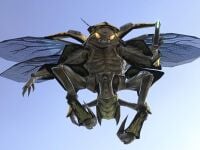
The best tactics for dealing with a Drone swarm is to hide behind cover and take the Drones down one at a time. Also, if a Drone boards a vehicle it will claw at the driver until they are killed, a certain amount of time has passed, or they themselves are killed. An effective, but dangerous way to remove them from vehicles is to ram the vehicle into a nearby wall or large structure. This does, however, risk the destruction of the vehicle and possibly death.
On the level Crow's Nest, if the player is vigilant enough, he/she can take and save a Deployable Cover from the hangar. After the Drones grab a Marine (seen through the mesh), run to the left and place it in front of the .50 Cal Turret. Doing so will enable one to shoot through and kill while avoiding the incoming Plasma Pistol shots from the Drones. Since Deployable Covers are commonplace on Crow's Nest, all the player needs to do is to seal up the pipes and keeping them from coming out.
One more simple and effective tactic to deal with Drones is when they are in a swarm, all that is required is a sticky grenade to stick one of them in the center, or an explosive (such as the Rocket Launcher) and most, if not all of the swarm, should be wiped out. The projectiles Brute Choppers fire can easily kill drones in one or two hits. This tactic can be used while sitting outside the first blue energy field on the level Tsavo Highway.
Halo 3: ODST
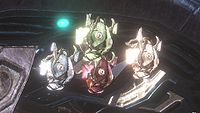
In Halo 3: ODST, there have been radical changes to the Drones. There are now several different colour schemes for the Drones, Minors are green, blue, or silver coloured, and they use needlers and plasma pistols. In contrast to popular belief, these drones do not have any form of energy shielding. Whenever a minor drone is killed, a field similar to that of an energy shield pops on and then off instantly. However, these are not recharging shields.
There has also been radical changes to the Drone Major, they now have red or gold exoskeletons and wield Brute Plasma Rifles. Drone Leaders possess recharging energy shields.
Drones have also received a running animation, featured prominently in the mission Data Hive. There they have been seen feasting on the corpse of Marines, and while they are sleeping, they do so hanging upside down on the ceiling, similar to bats.
Trivia
- The multiplayer map Guardian has visual similarity to the description of the Drone's home world Palamok, and the sounds of Yanme'e can be heard in the background.
- The nickname "buggers" is coincidentally the same name given to the Arachnids from Starship Troopers, and the Formic race in the Orson Scott Card novel Ender's Game. Additionally, the Drones' true name, Yanme'e, could be based on the Japanese 蜻蜓 (yanma), meaning "large dragonfly".
- Although the Yanme'e have been a part of the Covenant since at least before 2525, they were, along with the Huragok, predominantly used as technicians on board vessels until their effectiveness in combat was discovered during the attacks on New Mombasa. Also, despite their primitive appearance and mentality, Drones are actually an advanced race, and had attained "Tier 4" on the Forerunner Technological Advancement Scale, prior to their joining the Covenant.
- Flood infected Drones have not been seen, likely because a Drone has no basic skeleton upon which the Flood organism grafts its biomass into. However, the chitinous shells and liquid innards may be used as a source of biomass.
- In Halo 2, if a Drone is shot and killed in a certain way, their wings will jut out from their coverings like they were about to take off similar to that of a swatted fly or mosquito. While shooting them in Halo 3 can also cause their wings to jut out, using melee seems to always cause this to occur.
- The Drone is the only Covenant species not to appear in Halo Wars. Probably because they didn't fight twenty years prior to the Halo event, but were only mechanics, though this theory is doubtful, given that even the Engineers make an appearance in that game.
- Drones are described as having a slight musty odor associated with them.[9]
- It was once thought that Drones were very low in the Hierarchy of the Covenant, but in Halo 3: ODST, Grunts will go suicidal - as they do often when their Brute superiors die - when a red or gold drone is killed, and on exceedingly rare occasions, Brute Minors and even Brute Majors at times, will go berserk when they die.
- Apart from the brownish-green drones seen in Halo 3, several new types have been introduced in Halo 3: ODST. One of these is a bright green drone with a bio-luminescent midsection that glows orange. These drones are very weak and only require one body shot from a carbine to kill, even on higher difficulies. These drones may be the same ones found in Halo 2, as they appear very similar. There is another type that has a pale green shell and appears much more like the drones from Halo 3. Tougher blue and white drones now appear. They take considerably longer to kill than the pale green ones with a standard weapon like the SMG. Drone leaders now come in two varieties: gold and red. These leaders carry Brute plasma rifles and wear personal energy shields, similar to those of the Elites, but much weaker.[10]
- Although the red and gold drone leaders are the only variety that wear recharging energy shields, it would appear that all drones wear a very basic form of shields. Upon close inspection, one will see that just before a drones is shot to death, an energy shield pops on and off instantly. This kind of defensive system may be more similar to that of the Brutes. It is also worth noting that Drone leaders lack this weaker shield, as there is no energy pop just before their deaths.
- A Drone is the symbol for the Halo 3: ODST achievement Data Hive, as that level is not started by finding a clue.
- The Drones are the only Covenant which you can't command or have as an ally in any Halo game.
- According to Bungie, Drones cannot feel fear. This could be why they are never seen retreating, unlike the other species.
- If one is accurate enough, it is possible to score a headshot on a Drone. However, this only appears possible in Halo 3: ODST.
Gallery
- 1215495677 43652110-Full.jpg
A Drone's blood stain.
The Yanme'e hive, as seen in Data Hive
Sources
- ^ HBO Forums Turpis means "dishonourable, disgraceful". Rex means "king".
- ^ a b Halo 2 instructional manual
- ^ www.halo3.com - Species Bio.
- ^ a b c Halo: Contact Harvest
- ^ Halo Encyclopedia p. 31
- ^ Halo: Contact Harvest, pg.
- ^ Halo 2
- ^ Halo 3
- ^ http://www.bungie.net/projects/odst/guide.aspx
- ^ Halo 3: ODST Firefight Mode
